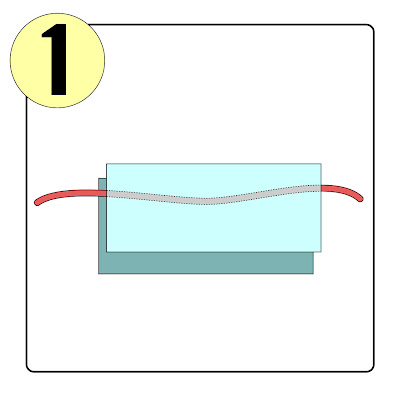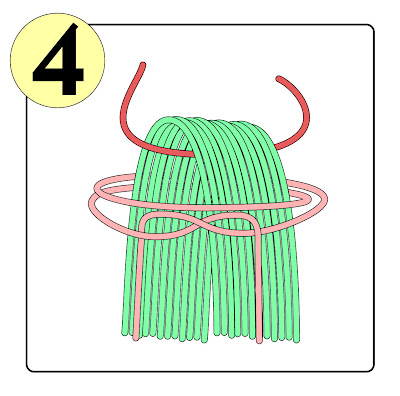Lining handknit caps with polar fleece is a good trick to know. (Click here for further information about polar fleece.) Lining with polar fleece can make too-big hats fit, and it eliminates wool itchiness from sensitive foreheads.
TECHknitting blog has already shown how to line knitted hats with polar fleece headband style; today's post shows how to fully line a hat. Basically, with this trick, you make another hat of polar fleece, then sew that inside your knitted hat. With a lining in a heavy weight of fleece, the hat will be suitable for arctic expeditions--excellent where I live (Wisconsin)--but in more temperate climates, you may want to search out a thinner fleece for your lining so the hat won't be impossibly hot.
Step 1 (below): Polar fleece stretches more from selvedge to selvedge than along its length. Cut out a strip from the "wide" way on the fabric (as shown by the "direction of stretch" arrow). The strip should be approximately 10 or 11 inches high and 24 to 26 inches wide. This strip will become the inner lining hat.

Step 2 (below): Wrap the strip around the intended wearer's head with the "not-so-good" side facing out and pin it shut. It would be wise to wear the pinned strip around the house for some time--what seems comfortably snug on first pinning can come to feel ear-numbingly tight after extended wear.

Step 3 (below): Sew the tube shut as pinned. If you have a serger, use that. With a sewing machine you can sew a simple straight seam. If you are sewing by hand, use the back stitch.

Step 4 (below): Trim the excess from the seam. The illustration shows pinking shears, but you can trim with ordinary scissors. Polar fleece does not unravel, so you can trim closer than with woven cloth. An approximately 3/8 inch seam allowance is good, but bold souls can trim as close as 1/4 inch, while nervous sorts can trim to a standard 5/8 seam allowance. If you do have a sewing machine, you might wish to re-sew over the cut edge with the machine's zig-zag or overcast stitch, but this is not necessary.

Step 5 (below): Have the intended wearer try on the tube. Pull the tube down well over the forehead so that you don't accidentally make the lining too shallow. Pin shut the top of the tube so that it comfortably conforms to the shape of the wearer's head. Below is an illustration, and at this link is a photo of the process in real life (Ravelry link).

Step 6: Just as you sewed the back seam of the tube in step 3, so now you will sew the top of the tube shut. Let the actual sewing of the seam be approximately 1/2 inch above the pins, and this should allow plenty of wiggle room.
Step 7: Just as you trimmed the excess from the seam allowance in step 5, so you will trim the excess fabric from above the top seam. Use the same width of seam allowance as on the back of the tube--somewhere between 1/4 inch and 5/8 inch.
Step 8 (below): OPTIONAL Have the wearer try on the sewn-shut tube. At this point, if you like, you can adjust the shape of the tube to be more anatomically correct by flipping up the front of the hat until the tube sits comfortably on the head. Once the comfortable amount of front flip has been determined, mark the flip with a line of pins.

Step 9: If you did step 8, then in this step, you trim away the excess fabric from the front of the lining by trimming along the pinned line. You want to flip up and trim from the front, rather than the back so that you are not cutting through the back seam--cutting the back seam could possibly encourage that sewing in that seam to run out, while cutting in the front creates no problems at all. Remember, polar fleece fabric does not unravel.
Step 10 (below): You have now created a custom lining which will fit the wearer. At this point, you want to sew the lining into the hat. A polar fleece lining is sewn into a hat ONLY AT THE BOTTOM EDGE of the hat. There is no reason to sew it in along the top. By having the lining free-floating in the hat (attached only at the bottom edge) the hat will lay far smoother on the wearer's head than if the lining were attached at the top of the hat too.
Here is the how-to trick for pinning the lining evenly into a hat (or should I say--for pinning the HAT evenly inside the LINING!?)
Begin by turning the hat INSIDE OUT. Fit the lining OVER the hat, with the sewn seams of the
lining facing the inside of the hat. In other words,
- the hat will be encased, inside-out, inside of the lining
- the good side of the lining will be showing, and
- the not-so-good side of the lining (the side with the seams) will rest against the inside fabric of the hat.
(If you think you may have seen this diagram before, you have! This is the identical diagram from the post on headband-style lining, and, in fact, the two methods are the same!)

a: Holding the hat (gray shape) inside the lining (blue shape), S-T-R-E-T-C-H the hat and the lining with both forefingers into a long shape which can be stretched no further. This automatically centers the hat inside the lining. Pin the lining to the hat in these two spots.
Do you wonder how you can pin in the lining while your hands are inside the hat and band, stretching everything smooth? You can ask someone to help you, of course, but if you are alone, you can take a shortcut by pinning in one contact point BEFORE you start the stretching-out process, then pinch the hat and lining together where you find the second contact should go. Just be sure not to prick yourself with the pre-set pin, which would go right against one of your stretching fingers.
b. along one side, divide the length between the two pins in half by again stretching the hat and the lining until they can stretch no further. Pin this third contact point.
c. along the other side, repeat step b. Four points are now pinned.
d. again stretching between two contact points, set a fifth contact point at the half-way mark between two already-set pins.
e. repeat the "stretching to find the half-way point" 3 more times until a total of 8 contact points are securely pinned down.
f. the perfectionists among us may want to again halve each side length for a total of 16 contact points.
Do not be alarmed if the lining is larger than the hat OR if the hat is larger than the lining. Once you have sewn the lining in place, the hat and lining will fit one another very well. The larger item, whether hat or lining, is eased to the smaller one by means of stretching out the smaller item as you sew, stitch by stitch, with the pins in place to divide the sections equally so all the ease does not wind up in one big lump on one side of the finished hat.
Thus, a too-large hat can be eased onto a smaller lining by stretching the lining out as the hat is stitched to it. When the sewing is done, the excess fabric of the hat will be distributed in tiny little bite-size pieces all around the lining. As the lining is released from stretching--as it shrinks back to near its original shape--it will take the too-large hat with it. Similarly, hats made of heavily textured fabric (ribbing, cables) will "draw in" much more than the smooth lining. Accordingly, the hat must be gently stretched to fit the lining.
To explain in different words: "Ease as you sew" is sewing jargon for stretching the smaller item (whether hat or lining) to match the larger item (whether lining or hat) as you sew the two together. When you have sewn the garment and the lining together and you take your hand away, you will see that they both lay smoothly together, regardless of the fact that the smaller one has been stitched into a new, stretched position.
As to which stitch to use, you can follow these instructions for the overcast stitch. I highly recommend sewing linings into knit garments by hand, rather than by machine: the end result is nearly always nicer, and the hand-sewn overcast stitch allows for a flexible and comfortable connection between the lining and the hat.
--TECHknitter (You have been reading TECHknitting on: "How to line a knitted hat.")










